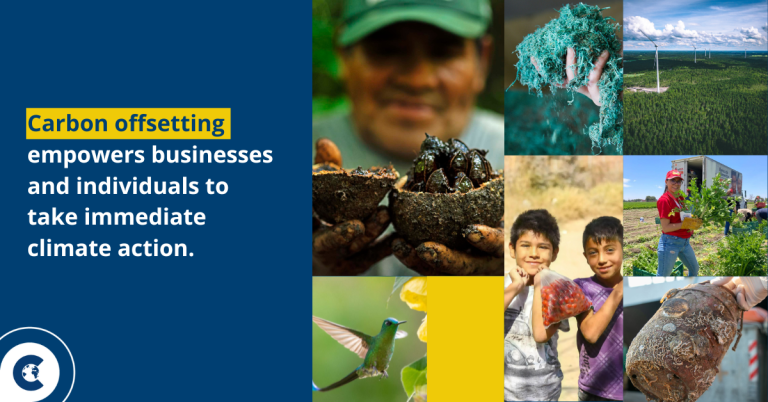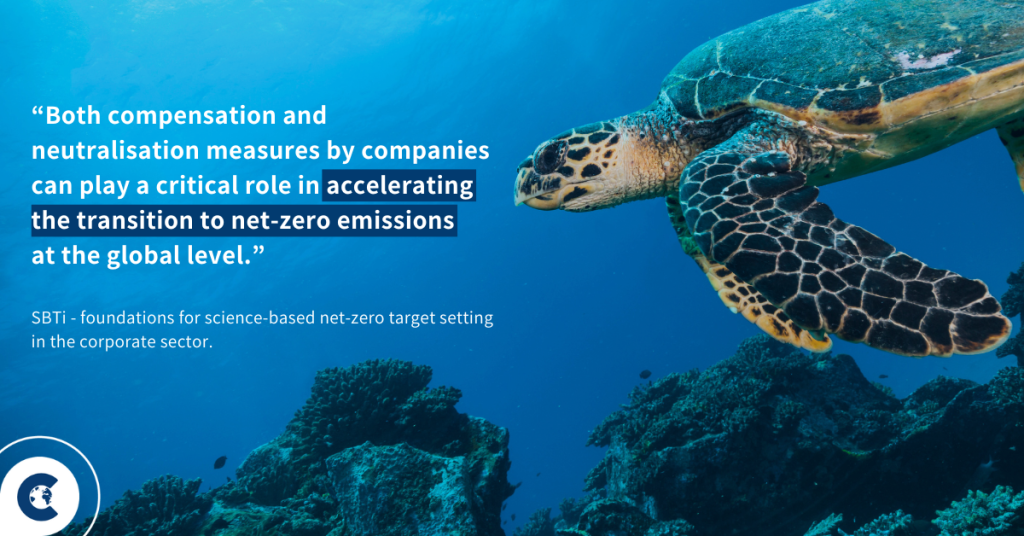Carbon offsets reduce emissions from resource consumption, shrinking your carbon footprint and benefiting the environment.
The UNFCCC defines carbon offsetting as a practice that enables both companies and individuals to “to compensate for the emissions they cannot avoid by supporting worthy projects that reduce emissions somewhere else.” To put it simply, carbon offsetting represents a proactive approach taken by organizations to voluntarily decrease, eliminate, or prevent the release of CO2 and other greenhouse gas emissions.
Carbon offsetting allows companies to compensate for their hard-to-abate greenhouse gas emissions, these are emissions that remain after reduction efforts, to balance out their carbon footprints. Companies can neutralize their remaining emissions by funding carbon offset projects around the world that reduce, remove, or prevent the release of GHGs into the atmosphere.
In this article, we explore the benefits of carbon offsetting and learn more about the methodologies used to calculate these offsets. We’ll also guide you on how to filter through projects and make carbon-neutral claims using carbon credits from the ClimateTrade Marketplace.

What happens when you purchase a carbon credit?
Carbon credits are a powerful tool in the fight against climate change. They allow individuals and businesses to take responsibility for their carbon emissions by investing in projects that reduce or remove an equivalent amount of greenhouse gasses from the atmosphere.
As a company, when you buy a carbon credit, you are buying a guaranteed and verified environmental outcome. The idea is that by purchasing ex-post credits, in other words credits where the CO2 reduction, avoidance, or removal has already occurred, you can make substantiated and credible claims about your own historic emissions. All offsetting standards have insurance allowances to cover for any chances of reversal, and all projects go through rigorous due diligence and regular auditing.
Carbon offset projects can also have other co-benefits not only for the environment but also for communities, such as better access to health and education, people’s well-being, and their social and economic prosperity. Moreover, carbon offsetting also contributes to the United Nation’s 17 Sustainable Development Goals (SDGs) like no poverty, zero hunger, good health, clean water and sanitation.
ClimateTrade hosts the world’s largest online marketplace that connects conscientious individuals and organizations with high-impact carbon offset projects around the world. When you purchase carbon credits on ClimateTrade’s marketplace, you support projects that positively impact local communities, promote sustainable development, and preserve ecosystems.

How to Choose a Carbon Offsetting Project
Selecting the right carbon offset project is essential to ensuring your contribution is effective and aligned with your values. At ClimateTrade, we offer a wide range of projects, each with unique environmental and social benefits. Here’s how you can choose the right one for you:
Identify your priorities: Determine whether you want to support renewable energy, reforestation, or other types of projects. Your choice should reflect your commitment to specific environmental and social outcomes.
Explore project details: Dive into the project profiles available on the ClimateTrade Marketplace. Each project is accompanied by comprehensive information, including its location, goals, and the number of carbon credits it generates.
Consider co-benefits: Many carbon offset projects provide additional advantages, such as job creation, poverty reduction, and biodiversity conservation. Think about how these co-benefits align with your values.
Consult the experts: ClimateTrade’s team of experts can help you navigate the marketplace, answer questions, and provide guidance to ensure your carbon offsetting choices are well-informed.
Exploring Carbon Credit Methodologies
Carbon credits are generated through various methodologies approved by international programs such Verified Carbon Standard.
These methodologies determine how emissions reductions are measured and verified, ensuring transparency and credibility in the carbon offset market. ClimateTrade strictly adheres to these standards, ensuring that the carbon credits you purchase are legitimate and verifiable.
Understanding the methodologies behind carbon credits is crucial for evaluating the impact of offset projects. ClimateTrade provides detailed information about the methodologies used in each project, so you can make informed decisions about which initiatives align with your carbon offsetting goals.
Carbon offset projects can be broadly classified into three types, based on the function of their environmental contribution to achieve the net zero target:
Reduction: projects that reduce GHG emissions through energy efficiency measures (such as clean cooking stoves, and clean drinking water) or renewable energy sources like wind and solar energy.
Avoidance: projects that avoid the release of GHG emissions such as forest protection, also called REDD+ projects.
Capture: projects that remove and capture released GHGs directly from the atmosphere (relative to a baseline) through nature-based solutions such as afforestation, reforestation and revegetation (ARR), or technology-based solutions such as direct air capture and carbon storage (DACCS).

Photo from ClimateTrade project: Protecting the biodiversity in Brazil, Unitor REDD+ project
How to Filter Projects in the ClimateTrade Marketplace
Choosing a carbon credit initiative to support amongst hundreds of options can feel somewhat overwhelming, but our platform offers user-friendly tools to help you find the most suitable project:
Search filters: Utilize filters like project type, location, price and SDG benefits to narrow down your options and find projects that resonate with your interests.
Explore individual project profiles: Open up a project you’re interested in and explore in detail the project overview, why it needs your support and learn more about what your impact would mean in terms of CO2 removal.
Recommendations: Utilize our carbon footprint calculators to measure your carbon emissions and choose projects that offset your exact carbon footprint, making your commitment to carbon neutrality even more precise.
Making Carbon-Neutral Claims with Carbon Credits
Once you’ve selected and purchased carbon credits through ClimateTrade, you can proudly make carbon-neutral claims for your organization or personal activities. ClimateTrade provides you with a certification and documentation to verify your carbon offsetting efforts, helping you demonstrate your commitment to environmental sustainability.
Offsetting your carbon footprint is not just a responsible choice—it’s a necessary one in the fight against climate change and It can significantly help toward our global transition to net-zero.
ClimateTrade’s marketplace empowers individuals and businesses to take meaningful action by supporting high-impact carbon offset projects worldwide. By choosing projects that align with your values and using legitimate carbon credits, you can play an essential role in creating a more sustainable and climate-friendly future.








